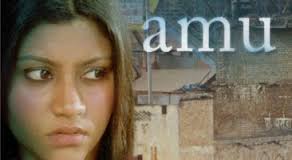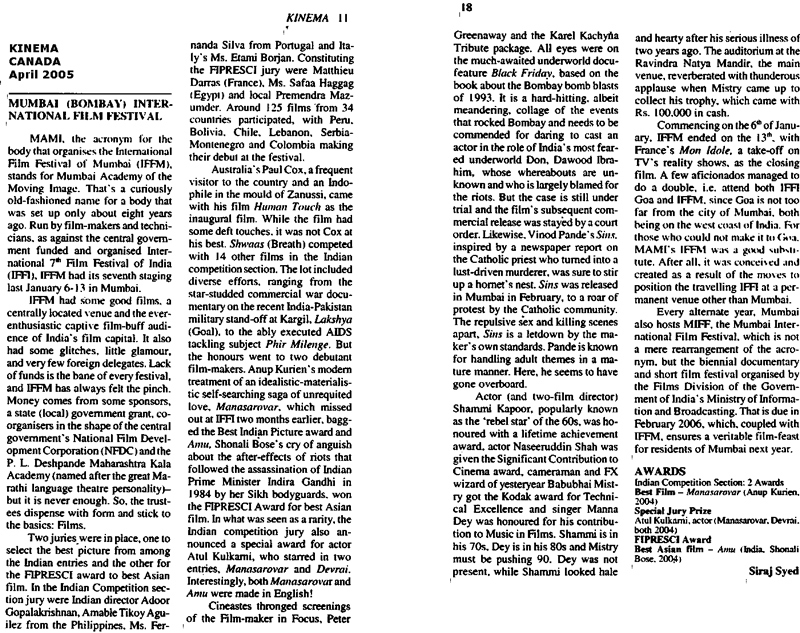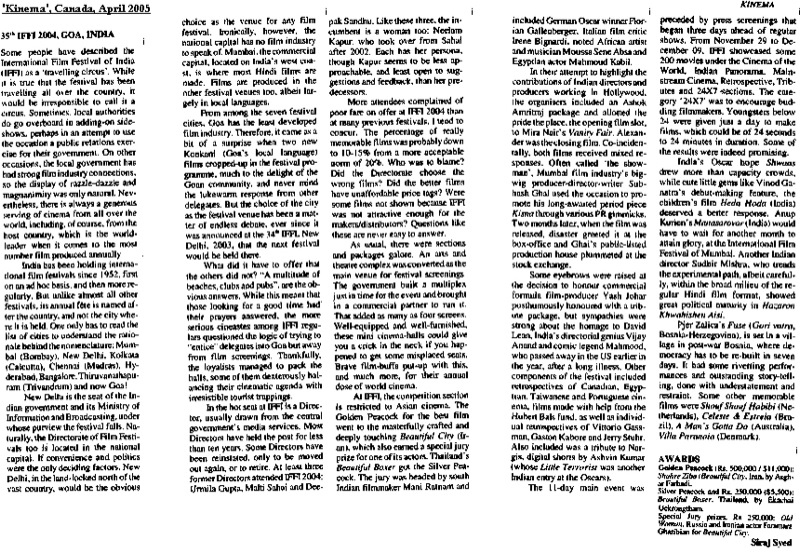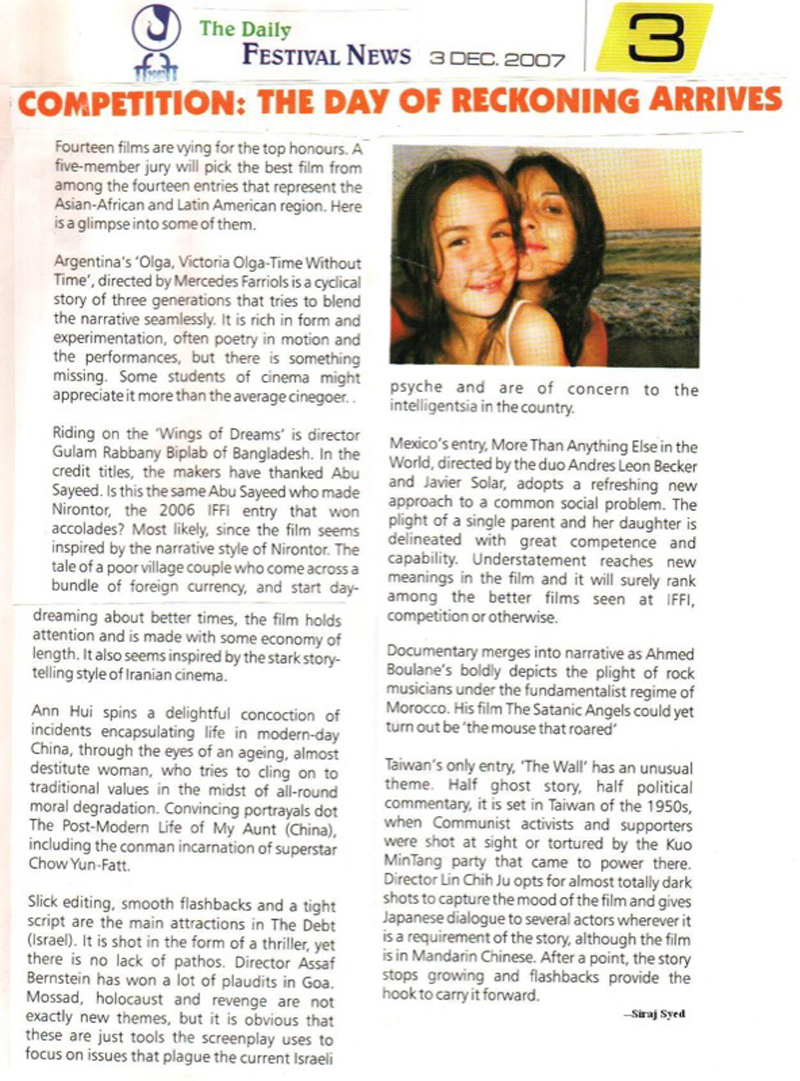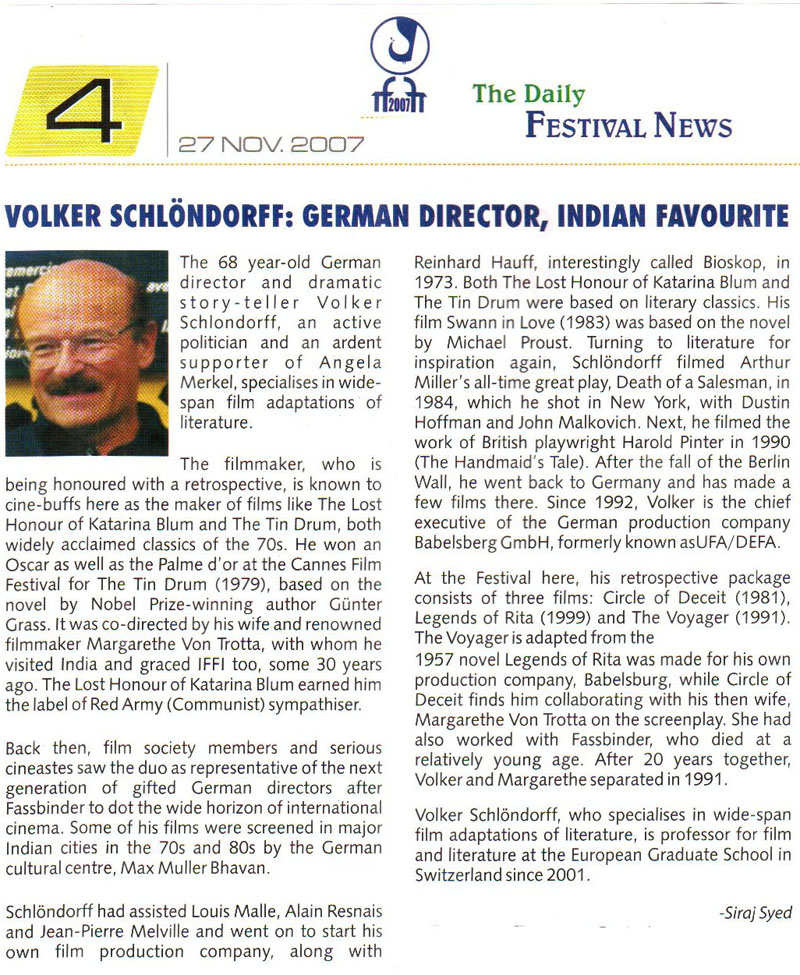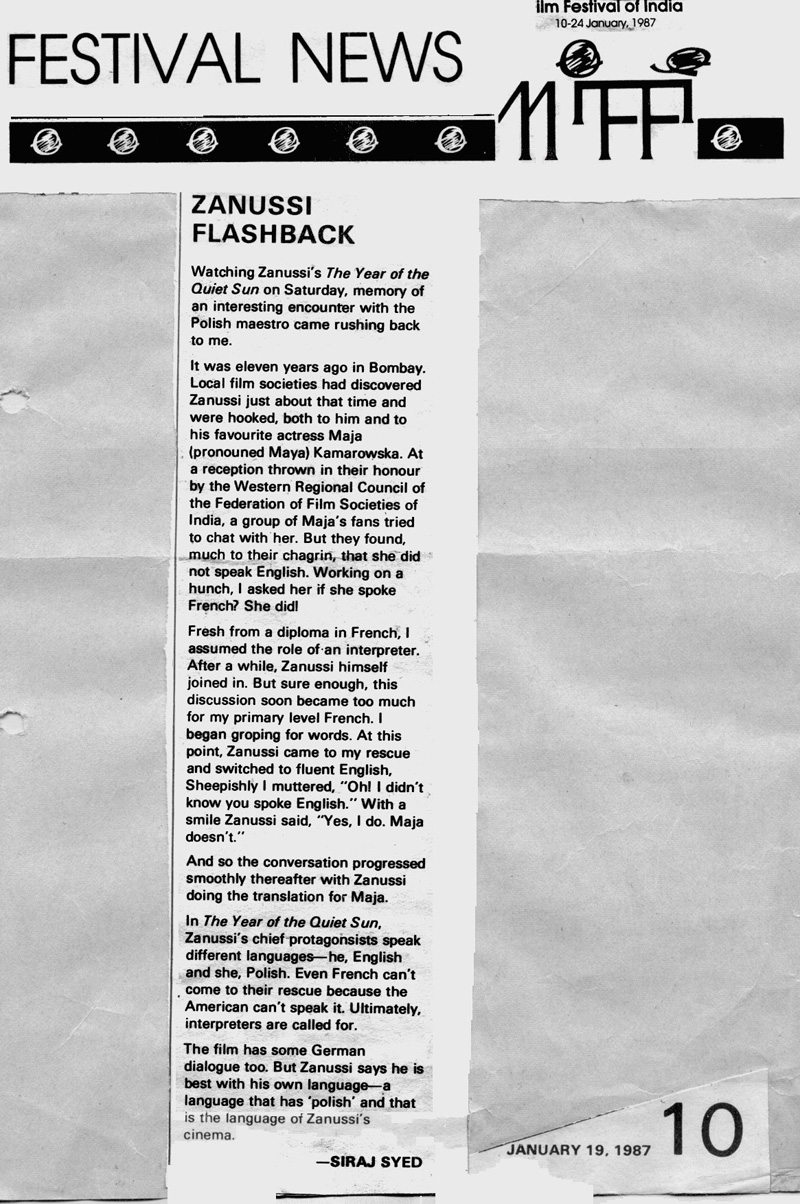|
|
||
|
Pro Tools
FILMFESTIVALS | 24/7 world wide coverageWelcome ! Enjoy the best of both worlds: Film & Festival News, exploring the best of the film festivals community. Launched in 1995, relentlessly connecting films to festivals, documenting and promoting festivals worldwide. Working on an upgrade soon. For collaboration, editorial contributions, or publicity, please send us an email here. User login |
MAMI’s MFF, Diary, Part II: 7th IFFM
MAMI’s MFF Diary, Part II: 7th IFFM, Jan. 6-13, 2005, Mumbai, India IFFM was into its 7th year when I returned from Singapore for good, and made got the first opportunity to attend the festival. Covering it for the academic publication, Kinema, I wrote: MAMI, the acronym for the body that organises the International Film Festival of Mumbai (IFFM), stands for Mumbai Academy of Moving Image. That’s a curiously old-fashioned name for a body that was set up only about eight years ago. Run by film-makers and technicians, as against the central government funded and organised International Film Festival of India (IFFI), IFFM had its seventh staging last January 6-13 in Mumbai. IFFM had some good films, a centrally located venue and the ever-enthusiastic captive film-buff audience of India’s film capital. It also had some glitches, little glamour, and very few foreign delegates. Lack of funds is the bane of every festival, and IFFM has always felt the pinch. Money comes from some sponsors, a state (local) government grant, co-organisers in the shape of the central government’s National Film Development Corporation (NFDC) and the P. L. Deshpande Maharashtra Kala Academy (named after the great Marathi language theatre personality)-- but it is never enough. So, the trustees dispense with form and stick to the basics: Films. Two juries were in place, one to select the best picture from among the Indian entries and the other for the FIPRESCI award to best Asian film. In the Indian Competition section jury were Indian director Adoor Gopalakrishnan, Amable Tikoy Aguilez from the Philippines, Ms. Fernanda Silva from Portugal and Italy’s Ms. Etami Borjan. Constituting the FIPRESCI jury were Matthieu Darras (France), Ms. Safaa Haggag (Egypt) and local Premendra Mazumder. Around 125 films from 34 countries were screened, with Peru, Bolivia, Chile, Lebanon, Serbia-Montenegro and Colombia making their debut at the festival. Australia’s Paul Cox, a frequent visitor to the country and an Indophile in the mould of Zanussi, came with his film Human Touch as the inaugural film. While the film had some deft touches, it was not Cox at his best. Shwaas (Breath) competed with14 other films in the Indian competition section. The lot included diverse efforts, ranging from the star-studded commercial war documentary on the recent India-Pakistan military stand-off at Kargil, Lakshya (Goal), to the ably executed AIDS tackling subject Phir Milenge. But the honours went to two debutant film-makers. Anup Kurien’s modern treatment of an idealistic-materialistic self-searching saga of unrequited love, Manasarovar, which missed out at IFFI two months earlier, bagged the Best Indian Picture award and Amu, Shonali Bose’s cry of anguish about the after-effects of riots that followed the assassination of Indian Prime Minister Indira Gandhi in 1984 by her Sikh bodyguards, won the FIPRESCI Award for best Asian film. In what was seen as a rarity, the Indian competition jury also announced a special award for actor Atul Kulkarni, who starred in two enties, Manasarovar and Devrai. Interestingly, both Manasarovar and Amu were made in English! Cineastes thronged screenings of the Film-maker in Focus, Peter Greenaway and the Karel Kachyna Tribute package. All eyes were on the much-awaited underworld docu-feature Black Friday, based on the book about the Bombay bomb blasts of 1993. It is a hard-hitting, albeit meandering, collage of the events that rocked Bombay and needs to be commended for daring to cast an actor in the role of India’s most feared underworld Don, Dawood Ibrahim, whose whereabouts are unknown and who is largely blamed for the riots. But the case is still under trial and the film’s subsequent commercial release was stayed by a court order. Likewise, Vinod Pande’s Sins, inspired by a newspaper report on the Catholic priest who turned into a lust-driven murderer, was sure to stir up a hornet’s nest. Sins was released in Mumbai in February, to a roar of protest by the Catholic community. The repulsive sex and killing scenes apart, Sins is a let-down by the maker’s own standards. Pande is known for handling adult themes in a mature manner. Here, he seems to have gone overboard. Actor (and two-film director) Shammi Kapoor, popularly known as the ‘rebel star’ of the 60s, was honoured with a lifetime achievement award, actor Naseeruddin Shah was given the Significant Contribution to Cinema award, cameraman and FX wizard of yesteryear Babubhai Mistry got the Kodak award for Technical Excellence and singer Manna Dey was honoured for his contribution to Music in Films. Shammi is in his 70s, Dey in his 80s and Mistry must be pushing 90. Dey was not present, while Shammi looked hale and hearty after his serious illness of two years ago. The auditorium at the Ravindra Natya Mandir, the main venue, reverberated with thunderous applause when Mistry came up to collect his trophy, which came with Rs. 100,000 in cash. Commencing on the 6th of January, IFFM ended on the 13th, with France’s Mon Idole, a take-off on TV’s reality shows, as the closing film. A few aficionados managed to do a double, i.e. attend both IFFI Goa and IFFM, since Goa is not too far from the city of Mumbai, both being on the west coast of India. For those who could not make it to Goa, MAMI’s IFFM was a good substitute. After all, it was conceived and created as a result of the moves to position the travelling IFFI at a permanent venue other than Mumbai. Every alternate year, Mumbai also hosts MIFF, the Mumbai International Film Festival, which is not a mere rearrangement of the acronym, but the biennial documentary and short film festival organised by the Films Division of the Government of India’s Ministry of Information and Broadcasting. That is due in February 2006, which, coupled with IFFM, ensures a veritable film-feast for residents of Mumbai early next year. AwardsIndian Competition Section: 2 AwardsBest Film – Manasarovar (Anup Kurien, 2004) Special Jury Prize – Atul Kulkarni, actor (Manasarovar, Devrai, both 2004) FIPRESCI AwardBest Asian film – Amu (India, Shonali Bose, 2004) 27.10.2014 | Siraj Syed's blog Cat. : Ambiance IFFM-2005 MAMI MFF
|
LinksThe Bulletin Board > The Bulletin Board Blog Following News Interview with EFM (Berlin) Director
Interview with IFTA Chairman (AFM)
Interview with Cannes Marche du Film Director
Filmfestivals.com dailies live coverage from > Live from India
Useful links for the indies: > Big files transfer
+ SUBSCRIBE to the weekly Newsletter Deals+ Special offers and discounts from filmfestivals.com Selected fun offers
> Bonus Casino
User imagesAbout Siraj Syed Syed Siraj Syed Siraj (Siraj Associates) Siraj Syed is a film-critic since 1970 and a Former President of the Freelance Film Journalists' Combine of India.He is the India Correspondent of FilmFestivals.com and a member of FIPRESCI, the international Federation of Film Critics, Munich, GermanySiraj Syed has contributed over 1,015 articles on cinema, international film festivals, conventions, exhibitions, etc., most recently, at IFFI (Goa), MIFF (Mumbai), MFF/MAMI (Mumbai) and CommunicAsia (Singapore). He often edits film festival daily bulletins.He is also an actor and a dubbing artiste. Further, he has been teaching media, acting and dubbing at over 30 institutes in India and Singapore, since 1984.View my profile Send me a message The EditorUser contributions |


















